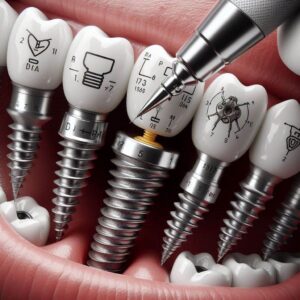Dental Code for Tightening Implant Screws: A Comprehensive Guide
Dental implants have revolutionized modern dentistry, offering a permanent solution for missing teeth. However, one common issue that both dentists and patients face is the loosening of implant screws. If not addressed promptly, a loose screw can lead to implant failure, bone loss, or infection.
This comprehensive guide will explore the dental codes (CDT codes) used for tightening implant screws, the clinical procedure, preventive strategies, and billing considerations. Whether you’re a dental professional or a patient seeking clarity, this article provides in-depth insights into maintaining implant stability.

2. Understanding Dental Implant Screws and Their Importance
Dental implants consist of three main components:
- Fixture (implant body) – Surgically placed in the jawbone.
- Abutment – Connects the implant to the prosthetic crown.
- Prosthetic crown – The visible tooth replacement.
The abutment is secured to the implant fixture via a small screw. Over time, due to mechanical forces, this screw may loosen, requiring retightening or replacement.
Why Proper Tightening Matters
- Prevents micro-movement, which can lead to bone loss.
- Ensures optimal force distribution during chewing.
- Reduces the risk of bacterial infiltration and peri-implantitis.
3. Common Reasons for Implant Screw Loosening
Several factors contribute to screw loosening:
| Cause | Explanation |
|---|---|
| Poor Initial Torque | Under-tightening during placement. |
| Occlusal Overload | Excessive biting forces. |
| Screw Fatigue | Metal fatigue from repeated stress. |
| Poor Fit of Components | Manufacturing defects or improper seating. |
| Bruxism (Teeth Grinding) | Excessive lateral forces. |
4. Diagnosing a Loose Implant Screw
Patients may report:
- A clicking sensation when biting.
- Slight movement of the crown.
- Discomfort or pain around the implant.
Clinical Examination:
- Visual inspection – Check for gaps between the abutment and crown.
- Tactile test – Use a dental probe to detect mobility.
- Radiographic evaluation – X-rays to rule out bone loss or screw fracture.
5. Dental Procedure Codes (CDT Codes) for Implant Screw Tightening
The Current Dental Terminology (CDT) by the ADA provides specific codes for implant-related procedures.
| CDT Code | Description | Notes |
|---|---|---|
| D6080 | Implant maintenance procedure | Includes screw tightening. |
| D2950 | Core buildup for a crown | If screw access requires filling. |
| D6104 | Implant removal (if screw is damaged) | Rare, only if replacement is needed. |
Note: Some insurers may bundle screw tightening under postoperative care, while others require separate billing.
6. Step-by-Step Procedure for Tightening an Implant Screw
- Patient Assessment – Confirm loosening via clinical and radiographic exams.
- Anesthesia (if needed) – Local anesthesia for sensitive cases.
- Accessing the Screw – Remove the crown or unscrew the healing cap.
- Cleaning the Screw Channel – Remove debris to ensure proper torque.
- Applying Correct Torque – Use a torque wrench (typically 20–35 Ncm).
- Sealing the Access Hole – Composite resin for screw-retained crowns.
- Post-Tightening Evaluation – Verify stability and occlusion.
7. Tools and Equipment Needed
- Torque wrench – Ensures precise tightening force.
- Hex drivers – Matches the screw design.
- Dental loupes/microscope – For better visibility.
- Composite resin – For sealing access holes.
8. Preventive Measures to Avoid Screw Loosening
- Proper initial torque application during placement.
- Occlusal adjustment to balance biting forces.
- Night guards for bruxism patients.
- Regular maintenance visits (every 6 months).
9. Complications of Improper Screw Tightening
- Over-tightening → Stripped threads or screw fracture.
- Under-tightening → Persistent loosening.
- Microbial leakage → Peri-implant infections.
10. Insurance and Billing Considerations
- Pre-authorization may be required.
- Documentation should include pre- and post-treatment X-rays.
- Patient responsibility if deemed non-covered maintenance.
11. FAQs
Q1: How often do implant screws need tightening?
A: Most cases remain stable for years, but periodic checks are recommended.
Q2: Can a patient tighten the screw themselves?
A: No, improper handling can damage the implant.
Q3: Is screw tightening painful?
A: Usually painless, but anesthesia can be used if needed.
Q4: What if the screw is stripped?
A: A replacement screw or abutment may be required.
12. Conclusion
Proper implant screw tightening is crucial for long-term implant success. Dentists must use the correct CDT codes (D6080) for billing, follow precise torque protocols, and educate patients on maintenance. Regular check-ups and preventive care minimize complications, ensuring implant longevity.
13. Additional Resources
- American Dental Association (ADA) CDT Codes – www.ada.org
- International Congress of Oral Implantologists (ICOI) – www.icoi.org


